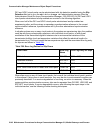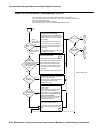
SYNC (Port-Network Synchronization)
Issue 1 June 2005 2147
● When both the primary and secondary source become valid, the system switches to the
primary source, since the primary source is always preferred over the secondary source
when both sources are equally healthy.
Synchronization Troubleshooting
For Stratum-4 operation, major and minor alarms indicate that there is a problem with the
system synchronization references. These alarms will be resolved when the alarmed
synchronization reference is restored.
The change synchronization command allows primary and secondary references to be
administered per cabinet.
Use status synchronization to show the current synchronization reference per cabinet.
Use display synchronization or list synchronization to show the primary and/or
secondary synchronization references that are administered.
Other commands associated with Synchronization Maintenance are disable
synchronization-switch and enable synchronization-switch. These commands
are used to disable the ability of Synchronization Maintenance to switch between
synchronization references and to enable this switching ability, respectively. Use set
synchronization only after synchronization has been disabled, to manually switch to a
specific synchronization reference. Use set synchronization to help diagnose
synchronization problems by forcing a specific reference (DS1, UDS1, or Tone-Clock) to be the
system synchronization reference to determine if a specific reference is providing a valid timing
signal.
Troubleshooting Approach
Slip errors are the primary symptom associated with being un-synchronized.
A correct Synchronization plan for the network keeps the systems within the network
transmitting data at approximately the same rate to avoid situations where:
● One system transmits data at a rate faster than another system can receive the data (in
which case data is lost).
● One system transmits data at a rate slower than another system expects to receive data
(in which case data is repeated).
Either of these situations, data being lost or repeated, is a slip.
When troubleshooting synchronization problems when slips are the primary error log entry
indications of a synchronization problem, requires that the problem be isolated to:
● A problem outside of the switch (That is, the switch is not properly synchronized to the rest
of the network.)
● A problem internal to the switch


















